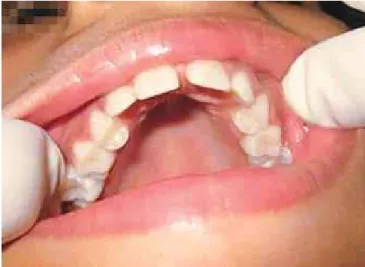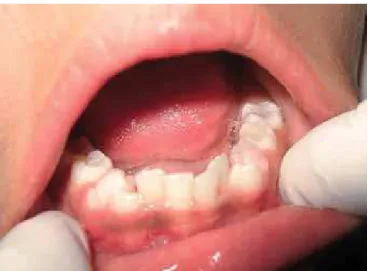Congenitally Missing Maxillary Primary Canines with Impacted Successors
Oral and Maxillofacial Pathology Journal, July-December 2015;6(2):643-645 643
OMPJ
Congenitally Missing Maxillary Primary Canines with
Impacted Successors
1Mahesh Shenoy, 2TL Yogesh, 3MS Shivakumar
ABSTRACT
Hypodontia is quite uncommon in the primary dentition in which lateral incisors are the most commonly missing primary teeth in the patients affected. Studies have shown that hypodontia in the primary dentition involving only maxillary canine is rare. One case of hypodontia in the primary dentition involving only maxillary canines is presented here with impacted permanent canines. In children with congenitally missing maxillary canines, the permanent dentitions may show diverse anomalies in tooth numbers, ranging from hypodontia to hyperdontia. Impaction of maxillary canines is a frequently encountered clinical problem which usually requires an interdisciplinary approach. Hence, it seems worthwhile to focus on the means of early diagnosis and treatment of this clinical situation.
Keywords: Hypodontia, Agenesis, Primary maxillary canine, Impacted canines.
How to cite this article: Shenoy M, Yogesh TL, Shivakumar MS. Congenitally Missing Maxillary Primary Canines with Impacted Successors. Oral Maxillo fac Pathol J 2015;6(2): 643-645.
Source of support: Nil
Conlict of interest: None
INTRODUCTION
Hypodontia is the congenital absence of one or more teeth in the dentition. It is a common anomaly that affects 20% of the population. Several studies have been reported with occurrence rate of 0.5% or less for agenesis, thus found to be rare anomaly in the primary dentition.1,2 Lateral incisors are the most commonly missing teeth in the primary dentition. It is seen that maxillary late-ral incisors were more commonly found missing than mandibular lateral incisors.3 Primary etiological causes
OMPJ
case rePOrt
10.5005/jp-journals-10037-1057
1Lecturer, 2,3Reader
1
Department of Diagnostic Sciences, Riyadh Colleges of Dentistry and Pharmacy, Riyadh, Saudi Arabia
2Department of Oral Pathology, Sri Rajiv Gandhi College of Dental Sciences and Hospital, Bengaluru, Karnataka, India
3Department of Oral Pathology, PMNM Dental College and Hospital, Bagalkot, Karnataka, India
Corresponding Author: Mahesh Shenoy, Lecturer, Department of Diagnostic Sciences, Riyadh Colleges of Dentistry and Pharmacy, PO Box: 84891, Riyadh: 11681, Saudi Arabia, Phone: +966-535048954, e-mail: mahesh.shenoy@riyadh.edu.sa
of permanent canine displacement include space dei-ciency, disturbances in tooth eruption sequence, trauma, retention of primary canine, premature root closure, rotation of tooth buds as well as localized pathological lesions (cysts, odontomas).4 Here, we are reporting a case of congenitally missing two maxillary primary canines with impacted successors.
CASE REPORT
An 11-year-old Indian male patient was brought to the faculty practice clinic with a complaint of missing primary upper canines and malaligned lower teeth with no previous dental experience. His medical history was unremarkable in that there was no history of super-numerary or congenitally missing teeth in his family. On intraoral examination, it was found that the patient was in the late mixed dentition period. The teeth present were permanent maxillary and mandibular incisors, irst molars, lower canines, primary upper and lower molars. Both maxillary primary canines were found to be missing clinically (Fig. 1) which was congenitally missing as conirmed by the parents. Both the parents and the kid were asked repeatedly regarding any extraction of deciduous maxillary canine or exfoliation during perma-nent lateral eruption. The clinical picture clearly showed no crowding in upper arch; however, there was crowding in lower arch but there was canine erupted in place—not of much concern. Mandibular primary irst molars were in exfoliating stage (Fig. 2). An orthopantomograph (OPG)
Mahesh Shenoy et al
644
taken for checking dental anomalies showed a mixed dentition with developing permanent teeth (third molars excluded). Orthopantomograph showed the presence of impacted maxi llary permanent canines, overlapping the root apices of lateral incisors and irst premolars (Fig. 3).
We could have expected exfoliation of deciduous maxillary canines if premolars were erupted but, in this case, deciduous molars were still in place and there was no crowding. Crowding was seen in lower arch but not upper and our case report was related to upper arch only. If deciduous maxillary canines were exfoliated during eruption of permanent lateral incisors there would have been some space distal to permanent lateral incisors.
The patient was advised orthodontic treatment after extraction of primary upper and lower molars which is an effective management option for children with impacted maxillary canines.
DISCUSSION
Recent reports have shown that the prevalence of hypo-dontia in the permanent dentition (third molars excluded) is about 4.5 to 7.4% in Caucasians, and the most commonly missing tooth is the mandibular second premolar. Com-pared with the situation in the permanent dentition,
hypodontia in the primary dentition is rare and its preva-lence has been found to be 0.5% or less in several studies.5 The incidence of hypodontia in the primary dentition varies ranging from 0.5% among the Swedish children to 1.0% among the Caucasians. However, a higher incidence of 5.0% in the primary dentition of Japanese children has been reported.6
Most studies showed a higher prevalence of hypodon-tia in females as was evident in the meta-analysis, which demonstrated a male to female prevalence ratio of 1:1.4 but the present case reported is of a male patient.1,7 The maxillary lateral incisor was the most frequently missing primary tooth, followed by the maxillary central inci-sor and irst primary molar. This case is interesting for several reasons: irstly, there are very few cases reported in the literature regarding congenital absence of only maxillary primary canines, which in itself is very rare. Secondly, radiographic evidence of this case showed the presence of the maxillary permanent canines which are impacted.
Studies have also shown that agenesis of a primary tooth was often followed by agenesis of the permanent successor.5 The current case showed the radiographic evidence of maxillary permanent canines which were impacted. Daugaard-Jensen et al had found that agenesis of a primary incisor was followed by agenesis of the permanent successor in 86% of cases.6,8 Witkop, in 1962, reported that 11 of 273 individuals with congenitally missing primary teeth also had congenitally missing permanent teeth. Thus, our case is not simulating to the literature studies. Early detection of ectopic maxillary canine teeth is important for carrying out an optimum interceptive treatment. However, late recognition and referral is a common problem.7,9
Both environmental and genetic factors can cause a failure of tooth development. Environmental causes may be due to the failure of tooth bud cell proliferation from the dental lamina which may be due to an infection (e.g. rubella, osteomyelitis), trauma, drugs (e.g. thalidomide), chemotherapy or radiotherapy at a younger age.10 In addition, Kjaer et al suggested that the pathogenesis of mandibular tooth agenesis was related to disturbances in nerve tissue, oral mucosa and supporting tissues; all of which interact during odontogenesis.11 Genetic causes may be associated with mutation of MSX1 and PAX9 genes. Tooth agenesis is probably caused by several inde-pendent defective genes, acting alone or in combination with others, which eventually lead to speciic phenotypes. Although tooth agenesis is associated with more than 49 syndromes, several case reports describe nonsyndromic forms that are either sporadic or familial in nature. Hypo-dontia is also often seen in syndromes associated with lip/alveolus with or without cleft palate.12,13
Fig. 2: Mandibular arch showing mixed dentition
Congenitally Missing Maxillary Primary Canines with Impacted Successors
Oral and Maxillofacial Pathology Journal, July-December 2015;6(2):643-645 645
OMPJ
The use of panoramic radiography along with a thorough clinical examination is recommended in detect-ing or conirmdetect-ing dental development. Methods of diag-nosis that may allow for early detection and prevention should include a family history, visual and tactile clinical examinations and radiographic assessment. When the condition is identiied early, extraction of the maxillary deciduous molars may allow the impacted canines to correct their paths of eruption and erupt into the mouth in relatively good alignment. This interceptive treatment may further reduce complications associated with pala-tally impacted canines including root resorption of the lateral incisors and the need for more complex surgical and orthodontic intervention.14
The success of early interceptive treatment for impacted maxillary cuspids is inluenced by the degree of impaction and age at diagnosis. As a general rule, when the degree of overlap between the permanent maxillary cuspid and the neighboring lateral incisor exceeds half the width of the incisor root, the chances for complete recovery are poor. Clinical studies purport resolution of palatal impaction in 91% of cases in which the crown of the canine is distal to the midline of the lateral incisor when treatment is initiated. The success rate drops to 64% if the cuspid crown is positioned mesial to the midline of the lateral incisor before interceptive treatment. Other fac-tors inluencing prognosis include canine angulation and crowding. Ericson and Kurol found that more mesially positioned canine cusp tips are associated with greater resorption of lateral incisor roots. Arch crowding can also have a signiicant inluence; moderate to severe crowding indicates the need for complex orthodontic treatment to resolve the impaction and the malocclusion.15,16
CONCLUSION
Congenitally missing primary teeth are a rare entity, when found should be thoroughly investigated and treat-ed. Simultaneously, the parents should be made aware of this condition and various modalities of treatment.
REFERENCES
1. Shashikiran D, Karthik V, Subbareddy VV. Multiple congeni-tally missing primary teeth: report of a case. Pediatr Dent 2002;24(2):149-152.
2. Litsas G, Acar A. A review of early displaced maxillary canines: etiology, diagnosis and interceptive treatment. The Open Dentistry Journal 2011;5:39-47.
3. Cho SY, Lee CK. Congenitally missing maxillary primary canines: report of three cases. Int J Paediatr Dent 2006 Nov; 16(6):444-447.
4. Bennett CG, Ronk SL. Congenitally missing primary teeth: report of case. ASDC J Dent Child 1980;47(5):34-37.
5. Ooshima T, Sugi K, Sobue S. Oligodontia in the primary dentition with permanent successors: report of a case. ASDC J Dent Child 1988;55(1):75-77.
6. Hunstadbraten K. Hypodontia in the permanent dentition. ASDC J Dent Child 1973;40(2):115-117.
7. Zhu JF, Marcushamer M, King DL, Henry RJ. Supernumer-ary and congenitally absent teeth: a literature review. J Clin Pediatr Dent 1996;20(2):87-95.
8. Leong P, Calache H. Bilateral congenitally missing max-illary canines: a case report. Australian Dental Journal 1999;44(4):279-282.
9. Jarvinen S, Vaataja P. Congenitally missing maxillary perma-nent cuspids. Report of a case. Proc Finn Dent Soc 1979;75(1-2): 11-12.
10. Becker A, Gillis I, Shpack N. The etiology of palatal displace-ment of maxillary canines. Clin Orthod Res 1999;2(2):62-66. 11. Jensen JD, Nodal M, Kjer I. Pattern of agenesis in the primary
dentition. A radiographic study of 193 cases. Int J Pediatr Dent 1997;7(1):3-7.
12. Vastardis H. The genetics of human tooth agenesis: new discoveries for understanding dental anomalies. Am J Orthod Dentofac Orthop 2000;117(6):650-656.
13. Peck S, Peck L, Kataja M. Concomitant occurrence of canine malposition and tooth agenesis: evidence of orofacial genetic ields. Am J Orthod Dentofac Orthop 2002;122(6):657-660. 14. Ferguson JW. Management of the unerupted maxillary
canine. Br Dent J 1990;169(1):11-17.
15. Power SM, Short MBE. An investigation into the response of palatally displaced canines to the removal of deciduous canines and an assessment of factors contributing to favour-able eruption. Br J Orthod 1993;20(3):215-223.

